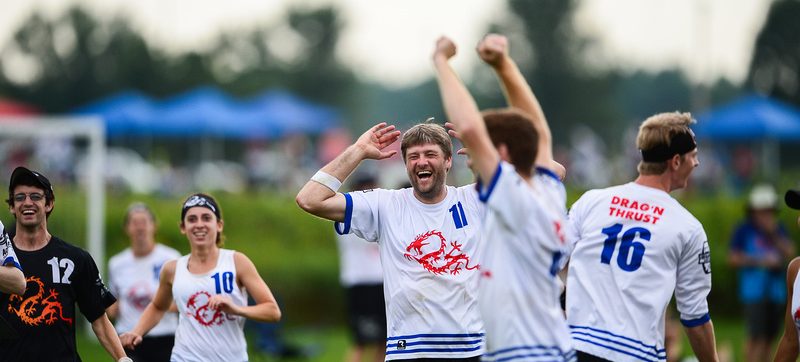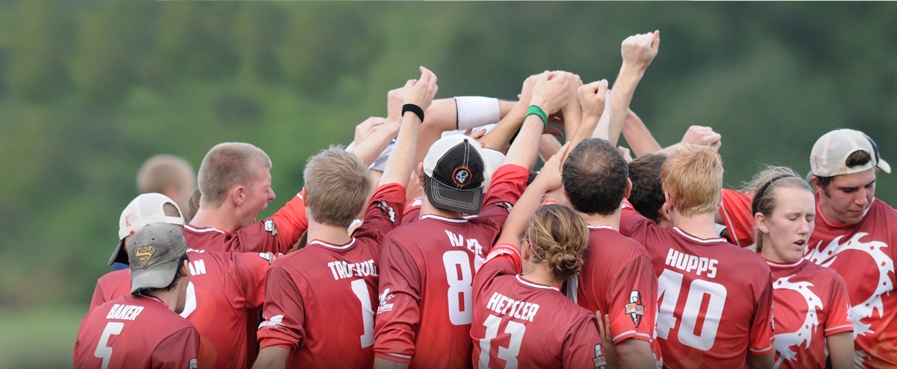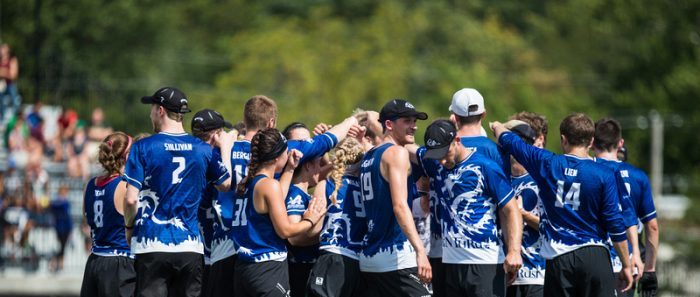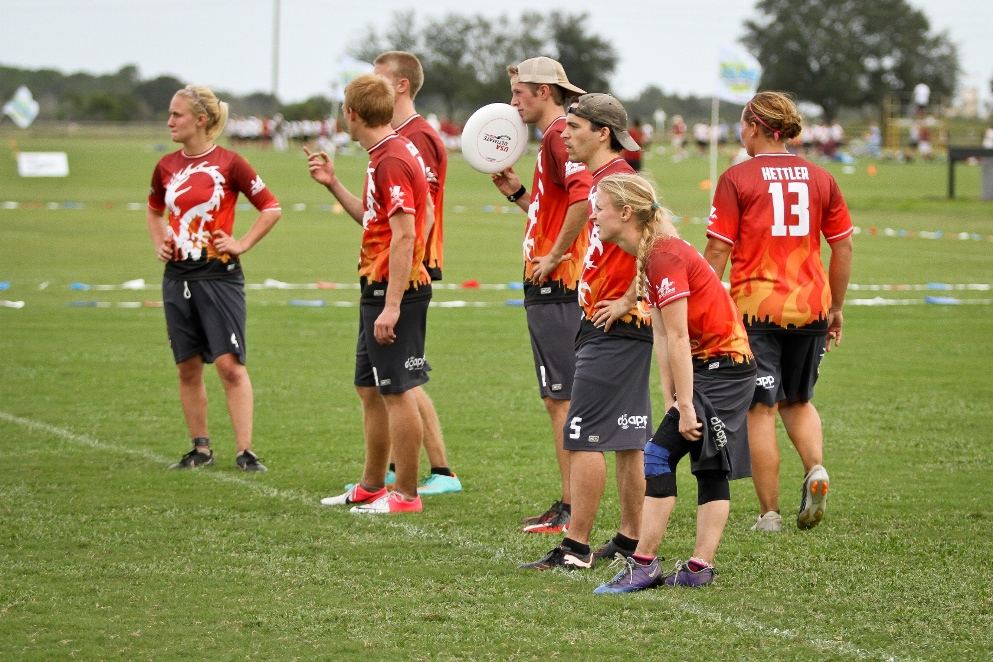
Photo by UltiPhotos.com
By: Jay Drescher
Defense is my one of my favorite aspects of ultimate. A good Defense will force the offense to throw something they don’t want to. That is the product of the entire defense doing their job in a 7 second period.
Let’s say your man catches the disc on the force sideline. Stall 1. He looks up-field at the next cut streaking under and sees your teammate hot on the cutters heels. The defense is too close to risk a throw with the potential of a layout D. Stall 2. Your opponent fakes the force side throw and looks off the cut. Stall 3. He then turns to the handlers (Stall 4) to see that your mark has tightened up take away the dump, making the throw to the handlers tough. By now it’s Stall 5. The first handler makes her cut up line,(Stall 6) but is bodied up and matched stride for stride as she clears up the force side. Stall 7. This leaves the second handler to cut. You hear your teammates yelling on the sideline to completely take away the dump. You shift your mark to synchronize with the throwers pivot and prevent the dump. Stall 8. The thrower is left with one option, the same cutter coming under who was looked off earlier in the point. The defense is on his heels. Stall 9. The throw goes up and all the work done by the defense in those 9.5 stalls is put into one chance to get a D. The defender lays out, and his fingertips thrusts between both outstretched hands of the cutter to tip the disc out of reach and to the ground. Your sideline erupts and you can feel the momentum starting to tip in your favor.
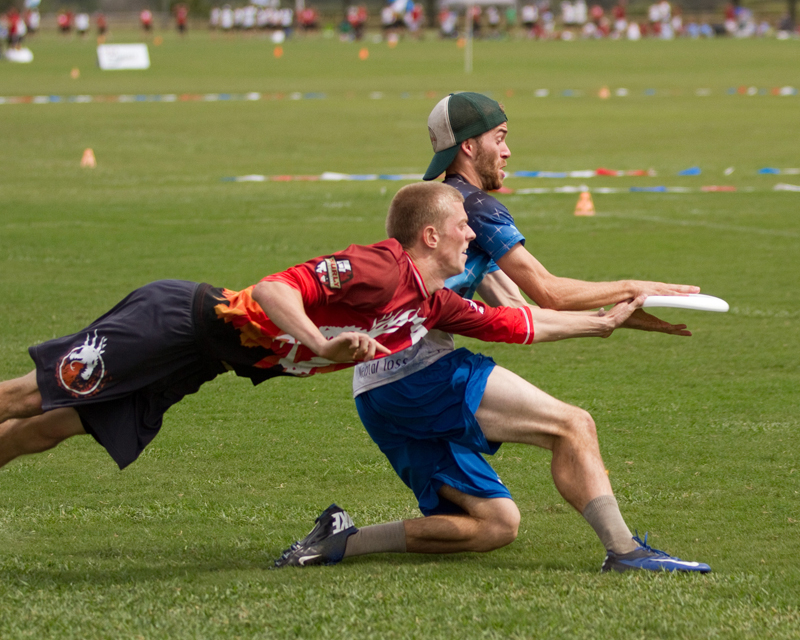
Photo by UltiPhotos.com
In order for that above play to end in a D the cutter defender used defensive fundamentals to be in the perfect position to make a play on the disc. If not, then the pass is complete and the offense scores. The nuances of defense is what keeps me coming back for more. I have watched a stack of footage of great ultimate defenders and NFL cornerbacks to see the little things they do so well. The main attribute that makes great defenders is playing against the best offensive players, and allowing only near-perfect throws to be completed. Every good defender knows he can be beat by a perfect throw. It is your job to make it a game of inches so the offense has to be perfect to earn their goal. This is done through smart positioning and fundamentals.
Spring Effect:
When guarding cutters, one issue I see a lot is biting on fakes or getting caught looking at the disc when the cut develops. I view the distance between my opponent and me as a spring. The closer I get to my opponent, the more force there is in the spring pushing back and slowing me down. On the other hand, the farther away you get from your opponent, the faster the spring is pulling towards her making up the separation. The goal is to always be traveling at the same speed as your opponent at a distance less than 2-3 yards away. It is extremely difficult to do this against elite offensive players and that challenge is what makes it fun!
Hips Don’t Lie:
There are small clues cutters or handlers reveal when picking a direction to cut. When faced with a one on one open field play, I will stare at the cutters hips to see which way they will turn. As Shakira said (and showed) Hips Don’t Lie! The hips are close to a player’s center of mass and that is what you are most worried about changing direction. The amount their hip turn is the same amount your hips can turn to match their direction.
Fun Fact:
The higher your center of gravity is the faster your theoretical top speed is. Reference
Marking:
Marking is the one of the most important parts of defense. It is one of the most difficult ones to master too. It is the first thing to suffer when I get tired on a long point. It is one of my weaknesses and I strive to constantly improve it. The goal of the mark is to protect the breakside not to generate turnovers. I learned a 3 point system that creates a consistent team oriented mark that is easy to remember.
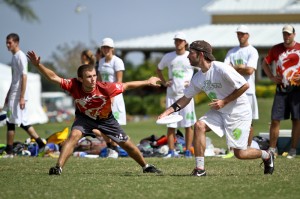
Photo by UltiPhotos.com
- Start marking the thrower pivoted to the force side close enough to take away the breakside of the field
- When the thrower pivots over to the break side your mark should move horizontally and slightly backwards to take away the around throw. This transition should be done quickly and be easy to keep your balance.
- If the thrower stays in the breakside pivot tighten up your mark slightly to take away more angles and apply more pressure to the thrower. If the thrower pivots back to the force side jump back to the original marking position. Rinse, Wash and Repeat till the T in 10.
Goal Line Defense:
As a legendary player from my college team in Duluth taught me, you need your knives/guns out when playing goal line defense. The guns are your attention, and just like a Western Standoff, you need them split between the disc and your opponent. This is difficult to do and requires you to be balanced, and quick on your feet to match the cutter’s rapid change of direction. I stare at a spot between the thrower and my cutter so I can see both players at once. My concentration is split 70% on the cutter and 30% on the thrower. Good throwers can have amazing fakes and cause you to bite too hard leading to an easy score. That is why I pay less attention to them. I like to think I rely on my reptile brain (basal ganglia) to alert me if the disc has been thrown. In the end zone I tighten up my defense to 1 yard of separation, and try to play perfect for 6 to 7 seconds.
Positioning/Field Awareness:
Positioning is something that has to be focused on every second the disc is in play. Knowing where to be at all times is difficult. You have to fight on defense not to give your opponent a significant advantage. One common mistake is playing off your opponent by 5 to 10 yards on the force side. This enables an open breakside option and also gives your opponent more speed to setup their cut while you are backpedaling. I try to be within 2-3 yard radius of my opponent, especially when guarding handlers. Playing tighter defense takes more effort, but it is worth every ounce of energy to have that chance to get a D. Tighter defense also forces the offense to work harder which enables amazing second half comebacks.
Field awareness is difficult to teach. I view field awareness as being able to see the play before it happens. As a basic example, if you see a handler starting her cut up line, you can prepare for a huck to come. However, everything is situational and I end up trying to disrupt what I think is the offense’s primary look. The objective is to be aware of where the disc is and where it is going. If you watch Dylan Freechild on his incredible game saving D against Doublewide, you can see his field awareness there. He was the deepest defender and his man was cutting under. Instead of blindly following his man he saw that the mark had been broken with a wide open breakside huck option. Dylan pulls off his man well before the deep throw goes up, and tracks down the throw committing with a huge layout. Dylan saw the disc move to the breakside and could see the deep throw happen before it did, which enabled him to be in the right spot at the right time.
Conclusion:
Practicing the above fundamentals to the point where they are instincts on the field helped take my defense up a level. If you couple that with intense physical workouts, and give it your all on the field you will be that girl or guy who is getting that layout D and become a game changer.

